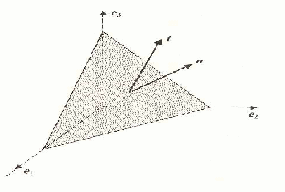The Navier – Stokes equation models the behaviour of a fluid element because of the forces acting on it, including viscous forces. When the viscous forces are ignored, the equations become Euler's equation. The equation is difficult to solve, and analytic solutions are only found for very simple examples. Usually the terms of the equation are assessed for important so that some can be dropped and the equation simplified.
The Navier – Stokes equation is
![]()
or![]()
Proof: The fluid velocity![]() of an inviscid (ideal) fluid of density
of an inviscid (ideal) fluid of density![]() under the action of a body force
under the action of a body force![]() is determined by the equation:
is determined by the equation:
![]() (Euler’s equation) where
(Euler’s equation) where![]() is the pressure. This equation is supplemented by an equation describing the conservation of mass. For an incompressible fluid this is simply
is the pressure. This equation is supplemented by an equation describing the conservation of mass. For an incompressible fluid this is simply ![]()
Real fluids are never truly inviscid. To take account of viscous forces we introduce the stress tensor![]() the
the![]() - component of stress on a surface element
- component of stress on a surface element![]() that has a normal
that has a normal![]() pointing in the
pointing in the![]() - direction then if
- direction then if![]() is the stress on a small surface element δS with unit normal
is the stress on a small surface element δS with unit normal![]() (1)
(1)
Proof of (1) : Take![]() to be the large face of the tetrahedron shown in the figure below.
to be the large face of the tetrahedron shown in the figure below.

Apply Newton’s 2nd law to the fluid in the tetrahedron. For definiteness consider the![]() -component of the force. The force of the surrounding fluid on the large face is
-component of the force. The force of the surrounding fluid on the large face is![]() The
The![]() - component of the force on the ‘back’ face is
- component of the force on the ‘back’ face is![]() (since the normal is in the
(since the normal is in the![]() direction). Similarly for the two faces with normals
direction). Similarly for the two faces with normals![]() and
and![]() Thus the
Thus the![]() - component of the
- component of the
total force exerted by surrounding fluid on the tetrahedron is ![]() (2) (
(2) (![]() indicates summation over
indicates summation over![]() ). This force (plus any body force) will be equal, from Newton’s 2nd law, to the mass of the element (
). This force (plus any body force) will be equal, from Newton’s 2nd law, to the mass of the element (![]() ) multiplied by its acceleration. If
) multiplied by its acceleration. If![]() is the linear
is the linear
length scale of the tetrahedron then![]() and
and![]() Thus if we let
Thus if we let![]() then the term (2) clearly dominates and hence
then the term (2) clearly dominates and hence![]()
The ith component of force exerted by the surrounding fluid on a fluid blob with surface![]() and volume
and volume![]() is given by
is given by
![]()
using![]() together with the divergence theorem. Applying Newton’s 2nd law to an arbitrary fluid blob then leads to the equation of motion:
together with the divergence theorem. Applying Newton’s 2nd law to an arbitrary fluid blob then leads to the equation of motion:
![]()
Applying an argument involving angular momentum to a tetrahedron, similar to the argument above using linear momentum, leads to the result that the tensor![]() is symmetric.
is symmetric.
In order actually to solve![]() it is necessary to relate the stress tensor
it is necessary to relate the stress tensor![]() to the fluid velocity
to the fluid velocity![]() For simplicity we consider only incompressible fluids for which the stress tensor is assumed to take the form
For simplicity we consider only incompressible fluids for which the stress tensor is assumed to take the form![]() - a Newtonian fluid, e.g. water and most gases under modest conditions - where
- a Newtonian fluid, e.g. water and most gases under modest conditions - where![]() is the viscosity.
is the viscosity.
Since![]()
![]() the mean of the three normal stresses.
the mean of the three normal stresses.
The final step in deriving the Navier - Stokes equation is to substitute![]() for
for![]() into equation
into equation![]() This leads to the equation (assuming constant viscosity
This leads to the equation (assuming constant viscosity![]() ),
),![]() - The Navier - Stokes equation.
- The Navier - Stokes equation.
